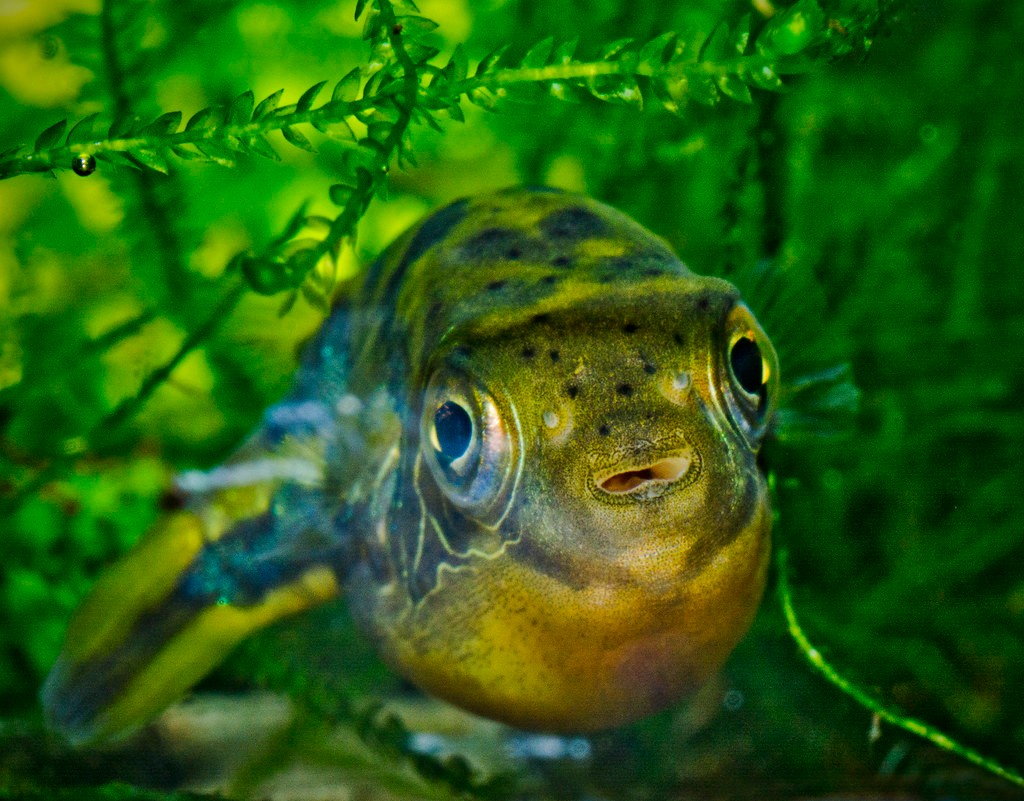The Dwarf Puffer Fish is an ideal specimen to keep as a pet in an aquarium, since unlike its common relative, its size makes it perfect for a small fish tank. If you want to know more about this type of fish, as well as its care, we invite you to continue reading this interesting article.

The Dwarf Puffer Fish
It is a type of fish that has the natural ability to inflate when a strong emotion such as fear or excitement is felt, taking the shape of a sphere when ingesting large amounts of water or air, considerably increasing its size. When deflated, it makes sounds and can spit water. It should be noted that being involved in an extreme situation that increases your blood pressure can even result in death. Smell is his most powerful weapon, serving as a guide due to his high degree of blindness.
It is native to Asia, particularly Sri Lanka, Indonesia, and northern China, and often resides in shallow waters and near riverbanks, in sandy, heavily vegetated areas. They can also be found in freshwater marshes and lagoons. On the other hand, the size of the dwarf puffer fish makes it perfect to acquire as a pet, since it varies between 2,5 and 3,5 cm. Its body is relatively large and round given the small dimensions that characterize it, without the presence of scales.
The head is large and strong, with large eyes and a delayed dorsal fin. It has very developed pectorals and its tail is small. The front teeth form a kind of beak, which facilitates feeding. It surprises with its elegant and hypnotic movements, although its slowness makes it difficult to maneuver in the face of its predators. Despite this, since it is a threatening situation that puts it in extreme danger, its ability to inflate can save its life by increasing its size, making it impossible to capture it.
It has a spectacular lemon yellow color, which is joined by bluish black spots, which become more brown when it changes mood and works as camouflage when it is on the gravel bottom. The belly is silvery white, without spots. Very striking is the fact that we are facing one of the few species capable of blinking or closing their eyes, which are large, bulky and extremely mobile despite their reduced vision. In addition, they are independent of each other, that is, you can only move to the right or left, leaving the opposite completely still.
Physical and Psychological Characteristics
The spotted fish, as it is also called, has an aggressive and dominant character, so if you decide to include several specimens in the same space, you must carefully follow the above instructions and incorporate plants and trunks in the aquarium, providing a place where hide and find the solitude and tranquility that he so much needs, isolating himself from the rest of his companions and thus ensuring a good coexistence between them. Otherwise, it will be aggressive towards other individuals, even attacking them by biting their fins if they are hungry.
Added to this is the secretion of a toxic substance called tetrodotoxin in the presence of any type of danger, resulting in the death of other tenants. The difference between males and females is basically that the latter reach larger dimensions in their belly, with a rounder shape and a whitish color. The male specimens, on the other hand, show a dark line along the belly and two lines behind the eyes that simulate two wrinkles. These qualities are more evident in adults, being very difficult to differentiate from the young.
These fish lay eggs on plants or substrate. The females deposit between 200 and 300 eggs on a rock that they have previously cleaned, and the males continue their fertilization and care. They are born at 4 or 5 days, time in which their parents ventilate them with their pectoral fins. The newborns are placed in the holes that the male dug in the substrate to protect them from predators. It is not a species that can reproduce easily. However, if you do manage to do this, you will need to house the hatchlings in separate tanks to prevent cannibalism between them.
Ideal aquarium for the Dwarf Puffer Fish
Its habitat can be an aquarium with 60 to 80 liters of water, preferably decorated with stones and logs, so it can hide and have fun. One thing to keep in mind is the use of medium stones, because if they are small you can pick them up and cause death. It prefers the lower part of the aquarium, where plants and logs can be placed to make it feel protected. Although it can live in both fresh and salt water, it is advisable to add a tablespoon or two of sea salt for every 10 liters of water.
The ideal temperature for this small pet is 27°C, although a range of 25-29°C, a gH of 5-10, and a pH of around 7.3 will suffice. In good conditions, the life expectancy of this living being can reach 8 years. Their diet consists mainly of live or frozen foods allowing for chunks of fish or meat. However, their favorite food is made up of live crustaceans or molluscs. Other delicacies for this little animal include worms, snails, mosquito larvae, maggots, clams, and cockles. It is not easy to satiate, which can lead to overfeeding.
If you liked this article about the Dwarf Puffer Fish and you want to learn more about other interesting topics, you can check the following links: